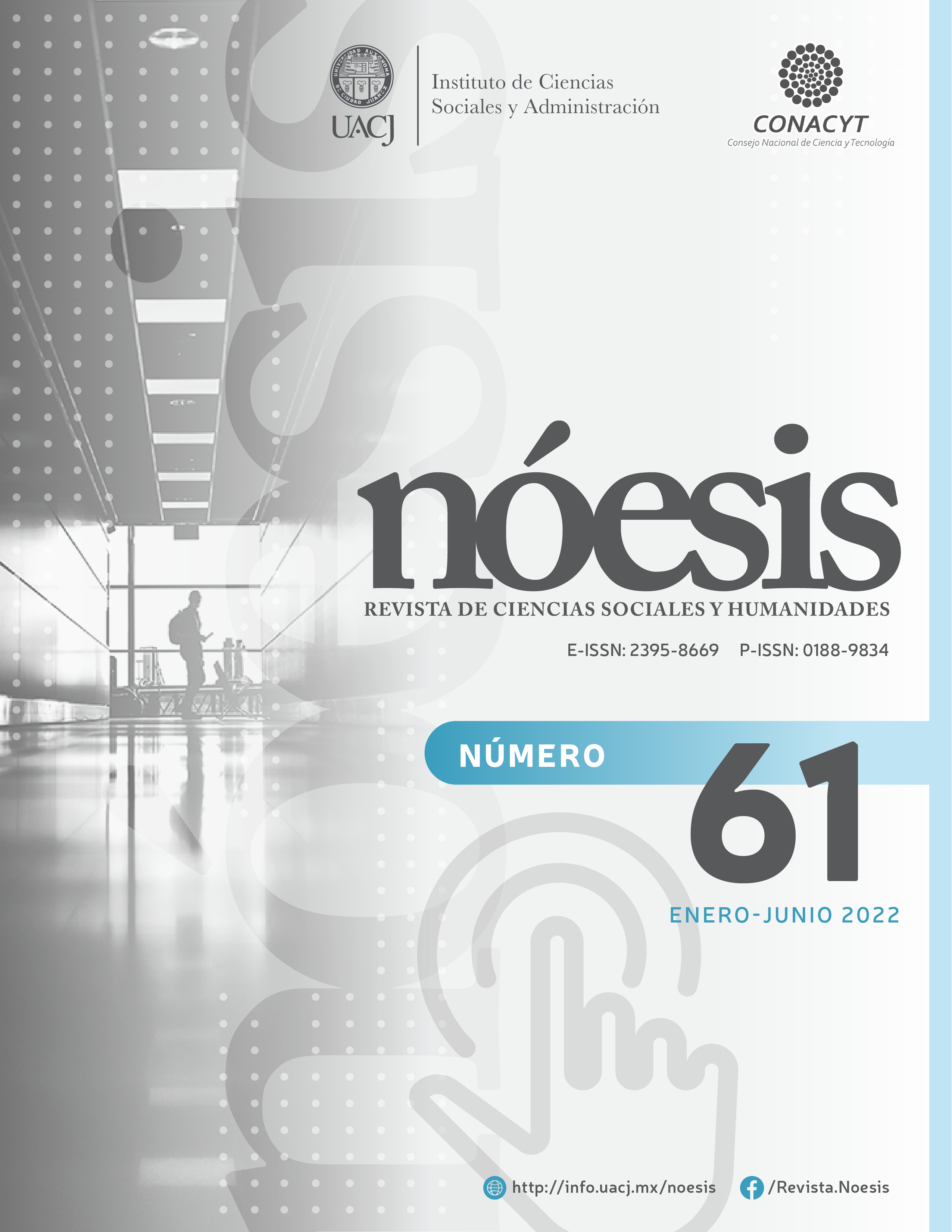Hardening of the Mexico-United States border and its impact on the remittances reception. The case of Ciudad Juárez in the context of Covid-19
Main Article Content
Abstract
This article ́s objective was to determine the impact of the hardening of the Mex-ico-United States border, particularly by the partial closure of the border due to Covid-19 –the migrant’s conglomeration in the city and the limitation of cross-bor-der mobility– in the reception of remittances in Ciudad Juárez. Applying linear re-gression model with ordinary least squares method and the Pearson and Spearman correlation analysis, we estimated the relationship between remittances with the number of border crossings and immigrant’s concentration in the city. The results show that the only statistically significant variable was the partial closure of the border, through a decrease in the number of crossings, which has a negative rela-tionship with the receipt of remittances in the locality, i.e., the fewer the number of crossings, the greater the receipt of remittances.
Downloads
Article Details

This work is licensed under a Creative Commons Attribution-NonCommercial-ShareAlike 4.0 International License.
References
Alarcón, R. y Becerra W. (2012). ¿Criminales o víctimas? La deportación de migrantes mexicanos de Estados Unidos a Tijuana, Baja California. Norteamérica, 7(1), 125-148.
Arango, J. (2003) La explicación teórica de las migraciones: luz y sombra. Migración y Desarrollo,1, 4-22.
Arroyo J. y Rodríguez D. (2008) Migración a Estados Unidos, remesas y desarrollo regional. Papeles de Población, 14(58), 41-72.
Barrios, MI., López, E. y Rubio, R. (2020). Flujos migratorios y Covid-19. La experiencia de los espacios filtro y de tránsito en Ciudad Juárez. El Colegio de la Frontera Norte. https://www.colef.mx/wp-content/uploads/2020/07/10_Espaciosfiltro.pdf
Borjas, G. (2000). Economics of migration. Harvard University Press.
Comisión Nacional de los Derechos Humanos (2018). Informe. Migrantes haitianos y centroamericanos en Tijuana, Baja California, 2016-2017. Políticas gubernamentales y acciones de la sociedad civil. El Colegio de la Frontera Norte, Tijuana. https://www.cndh.org.mx/sites/all/doc/Informes/Especiales/Informe-Migrantes-2016-2017.pdf
Corona, M.A. (2014). Las remesas y el bienestar en las familias de migrantes. Perfiles latinoamericanos, 22(43), 185-207.
Davis, S. (2008). Securitizing Infectious Disease. International Affairs, 84(2), 295-313.
Durand, J. (1988). Los migradólares: cien años de inversión en el medio rural, Argumentos: Estudios Críticos de la Sociedad. 84(2), 295-313.
Durand, J., Douglas, M. y Zenteno, R. (2001). Mexican Immigration to the United States: Continuities and Changes. Latin American Research Review, 36(1), 107-127.
Dunn, T. (1996). The Militarization of the U.S.-Mexico Border 1978–92: Low-Intensity Conflict Comes Home. The Center for Mexican American Studies Books [CMAS].
Flor, J.L. (2018). La seguridad sanitaria global a debate. Lecciones críticas aprendidas de la 24ª EVE. Comillas Journal of International Relations, 13(1), 49-62.
García y Griego, M. (1987). Origenes y supuestos de la Ley Simpson-Rodino de 1986. Foro Internacional. 3(107), 437-477.
López, P. y Cervantes, M. (2009). Migración y remesas en México: un análisis en el marco del TLCAN. Tiempo económico, 4 (11), 5-20.
Massey, D. y Espinosa, K. (1997). What’s driving Mexico-U.S. Migration? a theoretical, empirical, and policy analysis. American Journal of Sociology. 102(1), 939-99.
Massey, D., Durand, J. y Malone, N. (2002) Beyond Smoke and Mirrors. Mexican Immigration in an Era of Economic Integration. Sage.
Massey, D., Pren, K. y Durand, J. (2009). Nuevos escenarios de la migración México-Estados Unidos. Las consecuencias de la guerra antiinmigrante. Papeles de Población, 16(1), 101-128.
Organización Mundial de la Salud (2020). Brote de enfermedad por Coronavirus (COVID 19). Recuperado de https://www.who.int/emergencies/diseases/novel-coronavirus-2019
Organización Mundial de la Salud (2007). Informe sobre la salud en el mundo 2007. Protección de la salud pública mundial en el siglo XXI: un porvenir más seguro. Recuperado de https://www.who.int/whr/2007/07_report_es.pdf?ua=1
Taylor, J.E. (1999). The New Economics of Labour Migration and the Role of Remittances in the Development Process. International Migration. 37 (1), 63- 88.
Urciaga, J. (2006). Remesas, migración y desarrollo regional. Una panorámica. Análisis Económico, 21 (46), 2-21.

